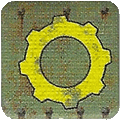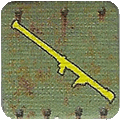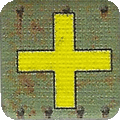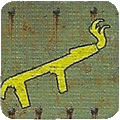August-September 1942
When the Germans initially arrived at the gates of Stalingrad in August 1942 the city was relatively weakly defended. They therefore made swift progress in pursuit of their objective of capturing the city. Important strategic points such as Mamayev Kurgan and the river crossing were seized. An early victory, however, was prevented by the timely arrival of a Russian reinforcement division which managed to drive the Germans back from the river bank and recaptured Mamayev Kurgan as well as large sectors of the city. Hitler, being adamant that the city be conquered, persisted in sending more and more troops into the city as did the Russians. After all, Stalin did not want to lose the city which bore his name!
The outcome of this battle has gone down into history as the first major defeat of the Wehrmacht in World War 2, which basically signalled the beginning of the end in the East. Had the Germans been able to decisively defeat the Russians in the early months of the battle, history might have taken a different course.
Will you be able, as the German player, to drive the Russians into the Volga? This will enormously compromise the entire supply system of the Red Army and at the same time free a lot of German troops to be used elsewhere. As for the Russian player, can you accomplish the same feat the Red army did in those Summer months of 1942 and tie up ever increasing numbers of German troops which will eventually lead to history repeating itself?
| Soviet | German | |
| Division 1 |
4 Squad Bases 1x 1x 1x |
5 Squad Bases 1 Panzer III 1x |
| Division 2 |
4 Squad Bases 1x 1x 1x 1x |
6 Squad Bases 1 Panzer III 1x |
| Strategy Decks | Artillery 1 Soviet Reinforcements (no trucks may be purchased) Ground Support 1 |
Artillery 2 (See special rules; Mamayev Kurgan) German Air Support 1 (remove tactical bombing) German Reinforcements 1 (no trucks may be bought) German Armored Reinforcements 1 (See special rules; German armored reinforcements) |
| Starting Strategy Cards | 1 | 3 |
| Operations Cards | 006 Merciless Assault (Shared) 007 Lay Razor Wire 010 Inspiring Leadership (Pavlov’s House Only) 013 Desperate Defenders 014 No surrender (Pavlov’s House Only) 017 Camouflage (Shared) 047 Katyusha Support 052 Lay Mines |
004 Double Time (remove at the end of the status phase of round 2 scenario reinforcements and events) Designer’s note: The double time card represents the initial light Russian resistance. 005 Clear Mines 006 Merciless Assault (Shared) 016 Clear Tank Trap 017 Camouflage (Shared) 018 Seize the Initiative 038 Panzer IV Ausf. E |
| Deployment Zone | Division 1: Any hex on maps 43A, 44A, 50A, 45B, 47A and/or 42B except on the German baseline. Division 2: Any hex on maps 45B, 47A, 42B, 5A, 51A and/or 41B except on the German baseline. |
Division 1: Moves onto the map with a move, move and fire or assault action. The first hex entered is any of the baseline hexes of maps 43A and/or 45B. The associated movement cost must be paid for the first hex entered. The German baseline is the westernmost row of hexes on these maps. For strategy card granted reinforcements follow standard game rules for deployment and except for the German armored reinforcements (see special rules) these must also deploy on the German baseline on the respective boards |
| Starting Initiative | Setup First |  |
| Objective | The Russian player scores 1 VP for each German infantry figure and/or light vehicle destroyed. They score 3 VPs for each heavy vehicle destroyed. The German player scores 5 VPs for each Russian baseline hex controlled at the end of round 12. Such a hex is considered controlled when a side was the last to have possession of it during the determine control over objectives step of the command phase. All the baseline hexes start under Russian control. In addition, both sides score 2 VP for each round at the end of which it controls the hex of Mamayev Kurgan that contains a victory point marker and 1 VP each for control of the Central train station, Pavlov’s house and the Grain Elevator (for locations see special rules). Note that regarding the Central train station, both hexes must be controlled by the same side to be able to claim the attached VP. The CP does go to the side controlling that particular hex. |
|
| Rounds | 12 | |
| Actions per turn | 2 | 3 |
| Reinforcements | The Russians receive the reinforcements in the status phases of round 2, 5 and 8. Note that the round 2 reinforcements may be attacked by the “Luftwaffe over the Volga” special option, if the German player so wishes. Any hits may be absorbed by the T34/76, if the Russian player so desires. The Russians start in control of all the scenario’s neutral and Russian VP and CP objectives; i.e. they do not need to begin or end their first action phase on these. To denote this, simply place a Russian control marker on said objectives at game-start. | - |
| Special Rules | * During set-up, the Soviets can place 2 trenches, 2 tank trap, 2 barbed wire, and 1 entrenchment markers anywhere on the map (even on the German entry hexes/baseline). For restrictions and options see special rules. | - |

Reinforcements:
The Russians receive their denoted reinforcements in the status phases of round 2, 5 and 8. Note that the round 2 reinforcements may be attacked by the “Luftwaffe over the Volga” special option, if the German player so wishes. Any hits may be absorbed by the T34/76, if the Russian player so desires.
The Russian round 2 reinforcements enter on the hex on the Russian baseline containing the 1 CP point marker and/or in the building hex directly adjacent to it (Pavlov’s house). Units that cannot be placed as the stacking limit would be exceeded, are lost.
The Round 5 and round 8 reinforcements are placed on any legal hex on the Northern map edge of map 41B (The half hex joining with map 51A may also be used for this purpose). If no hex is available for placement as they are either [intact] building terrain and/or enemy occupied, the reinforcements may not be placed and are lost.
Russian reinforcements that become available through being purchased from the reinforcements deck must be rolled for twice after purchase. First roll for troop quality: on a roll of 1-3 the base receives a second rate troop restriction.
On a 4+ it does not. If a squad is to receive a specialization token (e.g. “specialized reinforcements”) do not roll for troop quality! Then roll another die to determine which division the base belongs to: on a 1-3 the squad base belongs to division 1, on a 4+ to division 2. If belonging to division 1 they enter where the status phase reinforcements (round 2) do (when placed in Pavlov’s House, this must always be on the ground floor). If belonging to division 2, they would normally enter there too. However, see the special rules section as the Russians may pay additional command pointsto have these units enter on maps 5A,51A or 41B.
Finally, the Germans may purchase attack dice (See Luftwaffe over the Volga option) and attack the squad(s) and/or vehicles that enter play at or adjacent to the river crossing (only).
Special rules:
Pre-battle air bombardment: Before deployment, the German player rolls a die for each building hex on the map. On a roll of 1-2, the hex remains a building hex. On a roll of 3+, the hex becomes a collapsed building hex. Do NOT roll for the Grain Elevator; this building is to remain intact! As you will run out of collapsed building overlays, do one or more of the following to denote such a hex once you do:
Place a destroyed buildings marker from the Normandy expansion in the hex
Place a shell hole marker from the Normandy expansion in the hex
Place a ruins hex tile from memoir ’44 over the building hex
Use any other suitable way of distinguishing it from an intact building.
Note that tanks cannot use their concussive firepower ability against collapsed buildings and mortars may fire from such hexes.
Collapsed buildings: Collapsed building terrain is modified as follows: Block LOS. MC squads 3; MC heavy vehicles 4. Light vehicles may not enter. Heavy vehicles roll a die upon entering: 1-4 no result, 5= +1 hit; 6= immobile; cover squads: 2, cover vehicles 1. When heavy vehicles are placed in collapsed building hexes at set-up or as reinforcements, this die roll must still be made!
Mamayev Kurgan: The hill hex containing a VP marker yields 2 VP to the controller at the end of each game round (See victory conditions). This hex counts as a level 2 hill hex, the remaining hill hexes are level 1 hexes. In addition, the artillery of the side that controls the VP hex on Mamayev Kurgan receives the following benefits: cards with an attack value played by the side that controls the VP hex on Mamayev Kurgan hit on a 4+, artillery cards drift one fewer hex and any friendly squad that spots from the VP hex does so as if there were an officer present in it. Vehicles may not enter any of these hill hexes.
Panzergrenadiers: For each squad with a panzergrenadier specialization token, each friendly vehicle in the same hex gains +1 cover against close range attacks from squads (attach a tank damage token onto the squad base; yellow side facing to the back, to denote its specialization).
Designer’s note: Panzergrenadiers typically accompanied large armored formations. They often had halftracks and trucks at their disposal allowing them to keep up with the panzers. When tanks went unaccompanied by friendly infantry, this often allowed enemy soldiers to close in on the vehicles and take them out more easily.
Second-rate troops: A squad with a second-rate troop restriction (place a disrupted token on the squad base) receives -1 firepower [to a minimum of 1]. In addition, when a squad with a second-rate troops restriction token receives a disruption token, roll a die. On a 4+ the squad is routed immediately. For each officer in the same hex, subtract one from the die roll. A squad with a second rate troops restriction may never contain any elite figures. Note that unlike specialization tokens, squads containing a heavy weapon may be assigned a restriction token!
Luftwaffe over the Volga: When the Russian player receives reinforcements (either granted by the scenario or purchased from the reinforcement deck), the German player may, using available command, pay for a number of dice for the cost of 1 command point each. He then rolls these dice scoring hits on a 4+ (no cover or armor dice are rolled).
For each hit, a Russian figure is removed from the reinforcing squad(s) (owning player’s choice) or the hit is applied to a vehicle, if so desired. The German player may never buy more dice than the number of figures that the Russian player is to receive. For each vehicle a maximum of 1 die may be purchased, but multiple hits may be attributed to one and the same vehicle. Any remaining figures/vehicles are then placed on the board. Note that this option cannot be used against the “Hardened Veterans” strategy card or against units not placed at the river crossing and/or Pavlov’s House!
Rubble and debris strewn streets: Clear, road and railroad hexes play as follows: Squad movement normal, vehicle movement 2, squads have 1 cover. Do not block LOS. However, despite the cover granted, it does not count as cover providing terrain with regard to concealed squads, i.e. while they do roll at least one cover die when attacked in such terrain, for concealment/revelation purposes the terrain counts as clear terrain.
Into thin air: A squad, fresh or in op-fire, in a building hex (intact or collapsed) may, as an action, assign itself a concealed squad token if not adjacent to an enemy unit. Doing so costs 2 command points. However, a side can never have more than 2 concealed units on the board at any time. Pinned or disrupted squads may not perform this (special) action.
Dig trench/foxhole: Russian engineers may, as an action, place a trench marker in any hex they are in with the exception of [intact]building hexes. The engineer unit may enter that trench/foxhole as part of that same action.
Lay mines: Russian engineers may, as an action, place a mine token in any hex (type) they are in (including objective and building hexes; think of them as booby-trapped buildings).
Place tank trap/ road block/ obstacle: Russian engineers may, as an action, place a tank trap in a clear (incl. “road and railroad hexes”) or hill hex (including objective hexes).
Pavlov’s House: Pavlov’s House (the building hex next to the Russian 1 CP marker on the Russian baseline) has the following effects: Any Russian squads inside it, benefit from the No Surrender and Inspiring Leadership OP cards (in addition to the other Russian OP cards). It also yields 1 VP to the side that controls it at the end of each game round.
Grain Elevator: (The other building hex marked with a VP marker). It yields 1 VP to its controller at the end of each game round. In addition, it provides “6” cover to squads. It is at level 2 elevation.
Central Train Station: The double building hex on map 43A with a neutral 1 CP marker is the Central train station. It yields 1 VP to its controller at the end of each game round. Both hexes need to be controlled by the same side to qualify for this VP. The 1 CP goes to the side controlling that particular hex.
Vehicular board-edge movement: This rule is not used in this scenario.
Multi-level buildings: Area attacks do not only affect the top floor of a building. However, for each floor below it, add 1 cover die to the total number of cover dice.
Smoke: Smoke markers are removed at the end on the status phase of the same round.
Cautious advance: the optional cautious advance rule is a standard rule in this scenario! (Squads may choose to receive -2 movement, but gain +1 cover throughout their activation. May only be used with advance actions!)
Specialized reinforcements: Apart from the specializations listed on the specialized reinforcements strategy card in both sides’ reinforcements decks, both sides may choose an SMG or expert specialization token instead. The Russian player also has the option of choosing a Commissar or assault engineer specialization.
Combined strategy: Both sides may not draw from a certain strategy again until they have drawn from all decks at their disposal (place a fatigued counter on a deck when it is not available). Once all decks belonging to a certain side are marked with a fatigued counter, remove the counters. This means that at this point [only], a player could theoretically draw from the same deck again that they just drew from.
German armored reinforcements:
(For deck content see below)
Normally such (a) unit(s) would arrive on the German baseline. However, if the German player spends 2 CP extra the unit(s) may enter on map 44A (any legal Southern map edge hex(es)) and if he spends 3 CP extra on 50A (any legal Southern map edge hex(es)). The cost for the adjoining half hexes of 44A and 50A is 3 CP. Note that the above costs must be paid for each armored reinforcements strategy card.
Note that per standard game rules, vehicles may not set-up in or enter [intact]building hexes. Only German armored reinforcements may use the option of being placed elsewhere when the cost is paid. Units purchased from German reinforcement deck 1 are always deployed on their respective divisional points of entry on the German baseline.
Russian division 2 reinforcements:
As mentioned above, such squads would normally arrive on the map at the river crossing or adjacent to it in Pavlov’s House as would the units belonging to Russian division 1. However, if the Russian player spends 1 CP more than the printed cost on the card, division 2 units may arrive on map 41B (North edge), for two CP more on map 51A (North edge) and for 3 CP more on the North edge of map 5A. When a hex is made up of two half hexes on two different maps; pay the higher cost. Note that the two T34/76’s that become available as scenario reinforcements (rounds 5 and 8) must be placed on the Northern map edge of map 41B in any legal hex (at no command point cost).
Remember, if a unit is not placed at the river crossing or in Pavlov’s house, the German player may not use the Luftwaffe over the Volga special option!
The German armored reinforcements deck I contains the following cards:
1. Vehicle parts. Command Phase: choose one of your vehicles to remove a lightly damaged token from it, or flip a heavily damaged token to its light side. The cost of the card is reduced by 2 (to a minimum of 0) if you have at least one engineer unit in the vehicle’s hex. Command cost 3
2. Tank Ace. Command Phase: Place in your play area. Designate one of your armored units as a tank ace. This unit gains 2 firepower. Your opponent immediately receives 3 command points if this tank is destroyed. Command Cost 3
3. German Command tank: Command Phase: Place in your play area. At the start of each command phase receive one command and place it in your initiative pool. Command Cost 1
4. Munitions Resupply: Command Phase: Choose up to 3 vehicles and/or equipment units and assign them one of the Munitions tokens from FoTB and/or the Next Wave Core Set, which must be used on the following game round. If you do not, they are removed at the end of the following game round. Command cost * (1 per vehicle/equipment unit)
5. Armored reinforcements: Command Phase: receive 1 Panzer IV Ausf E. Command cost 3
6. Armored reinforcements: Command Phase: receive 2 Panzer IV Ausf E. Command cost 6
7. Armored reinforcements: Command Phase: receive 1 Panzer III. Command cost 2
8. Armored reinforcements: Command Phase: receive 2 Panzer III. Command cost 6
9. Armored reinforcements: Command Phase: receive 1 Stug E Assault gun. Command cost 3
10. Armored reinforcements: Command Phase: receive 1 Panzer 38T (use a Panzer III model with a German control marker next to it to distinguish it from the panzer III’s). Stats are as follows: MV 6; armor: 2; AI: 5-5; AV: 5-5. Overrun, concussive firepower, sturdy. Command cost 2
11. Armored reinforcements: Command phase: receive 1 sdkfz 251+ 1 squad of 4 regulars with a panzergrenadier specialization token. Command cost 3
Turret salvage: Action phase. As an action, you may have a friendly engineer squad remove a heavy damage token from one of your armored units in the same hex and replace it with an immobilized token. The engineer is fatigued as a result the tank is not. The tank regains its full firepower, does not suffer a penalty to its armor value, but may not move for the rest of the game. Command cost:2
Use [German]transported squad markers (1-8) to make the deck. The numbers written on them correspond to the text above.
Place the numbers face-down and make a deck. Draw from them as if they were a regular card deck. Use four concealed squad markers to represent numbers 9-12. The first time you draw one of these, it’s considered to be # 9, the second one # 10 etc. Should you have multiples in your play area, you can put dice next to it to remind you which one it is. If you actually need the markers on the board, it’s suggested you use American transported squad markers and concealed markers instead to form the draw pile for the armored reinforcements!
 Engineer
Engineer AntiTank
AntiTank Concealed
Concealed Medic
Medic Flamethrower
Flamethrower Starving
Starving Expert
Expert